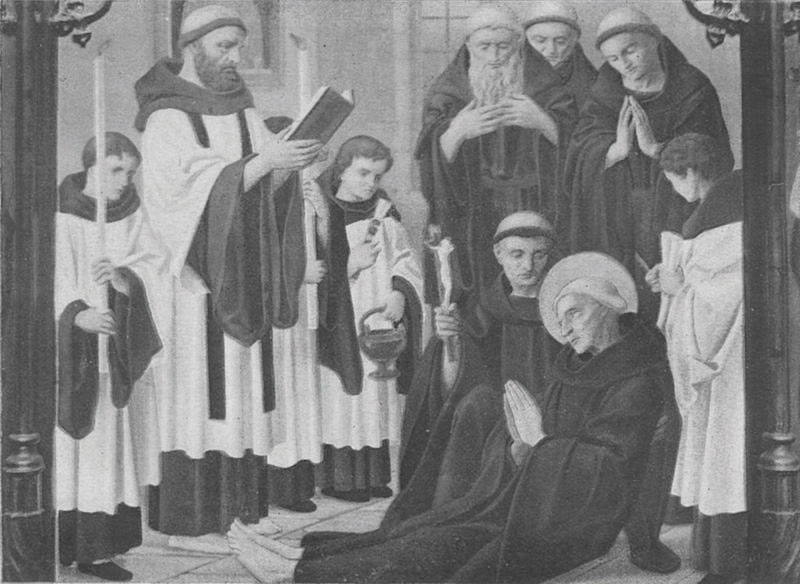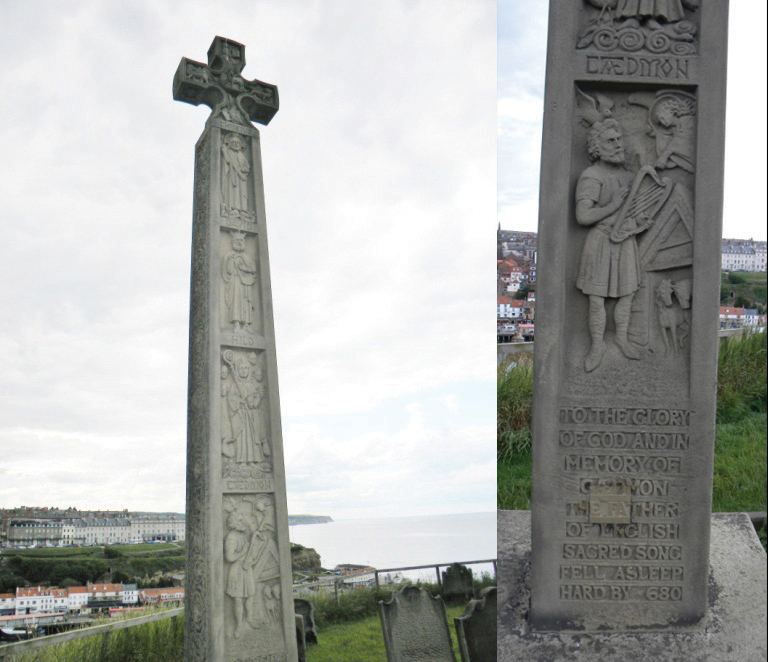This is ““Caedmon’s Hymn” and the Venerable Bede”, section 1.2 from the book British Literature Through History (v. 0.1). For details on it (including licensing), click here.
For more information on the source of this book, or why it is available for free, please see the project's home page. You can browse or download additional books there. To download a .zip file containing this book to use offline, simply click here.
1.2 “Caedmon’s Hymn” and the Venerable Bede
PLEASE NOTE: This book is currently in draft form; material is not final.
Learning Objectives
- Recognize the elements of Anglo-Saxon culture revealed in Bede’s story of Caedmon.
- Identify the Venerable Bede and appraise the importance of his work in our knowledge of Anglo-Saxon culture in Britain.
The Venerable Bede
The Venerable Bede, a monk from Northumbria, is the most important historian of the Anglo-Saxon period primarily because of his work the Ecclesiastical History of the English People. Although little is known about his life, Bede likely was born about 672 or 673 to a noble family and sent to the monastery of Wearmouth to be educated.

Death of St. Bede.
From his monastery at Jarrow, Bede visited the monastery on the Holy Island of Lindisfarne and wrote two books about the life and miracles of St. Cuthbert, Bishop of Lindisfarne Priory from 685–687. Both St. Cuthbert and the Venerable Bede are buried at Durham Cathedral.

Durham Cathedral.
Ecclesiastical History of the English People
Bede’s Ecclesiastical History of the English People records two important events that occurred at another abbey in northern England, the Abbey of Whitby.

Ruins of Whitby Abbey.
The Abbey of Whitby overlooks the North Sea in North Yorkshire, England. Founded in 657, the abbey’s first abbess Hilda was the niece of Edwin, the first Christian king of Northumbria.
The Venerable Bede records the story of King Edwin’s conversion to Christianity. Considering converting as part of a marriage arrangement, King Edwin asked some of his counselors for advice. The Venerable Bede records the advice that one of his counselors gave him:
Sidebar 1.2.
The present life man, O king, seems to me, in comparison with that time which is unknown to us, like to the swift flight of a sparrow through the room wherein you sit at supper in winter amid your officers and ministers, with a good fire in the midst whilst the storms of rain and snow prevail abroad; the sparrow, I say, flying in at one door and immediately out another, whilst he is within is safe from the wintry but after a short space of fair weather he immediately vanishes out of your sight into the dark winter from which he has emerged. So this life of man appears for a short space but of what went before or what is to follow we are ignorant. If, therefore, this new doctrine contains something more certain, it seems justly to deserve to be followed.
Like the Abbey at Lindisfarne, the Abbey at Whitby was sacked by Viking raiders and rebuilt. Also like other abbeys in England, it was closed at the Dissolution of the Monasteries by Henry VIII in 1536.
But long before Henry VIII, Whitby Abbey was home to Caedmon.
Recorded by the Venerable Bede in his Ecclesiastical History of the English People, “Caedmon’s Hymn” is the oldest extant work in the Old English language. It was probably composed during the latter half of the 7th century.
Part of this work’s importance is what it reveals about Anglo-Saxon society nearly one hundred years after the arrival of St. Augustine in 597. The poem pictures an Anglo-Saxon society in which the tribe gathers in the mead hall to eat and to entertain each other with songs about heroes and their adventures. But, in this story, for the first time, one of those traditional songs has a religious theme, illustrating the influence of Christianity on the pagan culture.
In his Ecclesiastical History of the English People, the Venerable Bede records the story of Caedmon, a simple, uneducated cow herder at the Abbey of Whitby who was given the gift of song in a dream/vision. Like others in Anglo-Saxon society, the monks followed the custom of passing around a harp after the evening meal in the great hall for everyone to take a turn singing/chanting a story. Caedmon used to sneak out before it was his turn because he couldn’t sing. Then he received his divine gift. The important point, however, is that he was given the gift of singing stories about religious subjects, specifically the creation of the world.

Caedmon’s cross near Whitby Abbey.
Sidebar 1.3.
Caedmon’s Hymn
Now praise the guardian of Heaven,
the might of the Creator, and his purpose,
the work of the Father of glory, how each of wonders
the Eternal Lord established in the beginning.
He, the holy Creator, first created
Heaven as a roof for the sons of men.
The holy Creator, the guardian of mankind,
the Eternal Lord, the Almighty Lord
afterwards made Middle-earth, the earth for men.
In the beginning Cædmon sang this poem.
Anglo-Saxon songs and stories were always about battles, heroic but violent deeds, monsters—stories like Beowulf. The story of Caedmon pictures the use of the Anglo-Saxon custom of singing in the mead hall to introduce Christian stories to the pagan Anglo-Saxons.
Illuminated Manuscripts
After the Anglo-Saxon invasions and before the Norman Conquest, literacy in Britain was almost entirely the province of the monasteries. As we see in Bede’s The Ecclesiastical History of the English People, monks were responsible for the recording of what history and literature exists from the Anglo-Saxon period.
One of the highlights of this period was the production of illuminated manuscriptshandwritten manuscripts adorned with richly colorful, intricately crafted illustration, often using expensive materials such as gold leaf, handwritten manuscripts adorned with richly colorful, intricately crafted illustration, often using expensive materials such as gold leaf. One of the most famous illuminated manuscripts is the Lindisfarne Gospels. The British Library’s online virtual books feature allows you the experience of leafing through this rare and valuable manuscript.
Key Takeaways
- The Venerable Bede’s The Ecclesiastical History of the English People is one of the few sources of information about Britain in the Anglo-Saxon period.
- The story of Caedmon the cow herder may have been composed to account for the introduction of religious topics to the Anglo-Saxon story-telling tradition.
- The creation of illuminated manuscripts is a highlight of medieval literature and art.
Exercises
- Read the story of Caedmon in The Ecclesiastical History of the English People. What do you learn about daily life in a monastery from reading this passage? What do you learn about Anglo-Saxon culture?
- After reading the story of Caedmon, how would you characterize Bede’s work? What would you consider the main purpose of his work?
- Describe what you consider the outstanding features of the Lindisfarne Gospels.
Resources
Biographical Information on Caedmon
- “Caedmon.” Dictionary of National Biography.
- “St. Caedmon.” The Catholic Encyclopedia.
Biographical Information on The Venerable Bede
- Biography of The Venerable Bede. Calvin College Christian Classics Ethereal Library.
- Image of Bede’s tomb in Durham Cathedral. Durham Cathedral.
- The Venerable Bede. BBC. Audio of panel consisting of Richard Gameson, Reader in Medieval History at the University of Kent at Canterbury; Sarah Foot, Professor of Early Medieval History at the University of Sheffield; Michelle Brown, manuscript specialist from the British Library.
- “The Venerable Bede.” History. Historic Figures. BBC.
- “The Venerable Bede.” Religion Facts. Biography and images of Bede and Bede’s tomb.
Text of “Caedmon’s Hymn”
- “Caedmon’s Hymn.” Poemhunter.com. Old English and Modern English.
- “Caedmon’s Hymn.” Representative Poetry Online. Old English and Modern English with commentary by Ian Lancashire, Dept. of English, University of Toronto.
Audio
- Anglo-Saxon Aloud. Michael D. C. Drout. Wheaton College. Recording in Old English.
- “Caedmon’s Hymn.” Internet Archive. Librivox. Recording in Old English.
- “Caedmon’s Hymn.” Project Gutenberg. Recording in Modern English.
Video
- “The Venerable Bede and ‘Caedmon’s Hymn.’” Dr. Carol A. Lowe. McLennan Community College.
Ecclesiastical History of England Text
- Ecclesiastical History of England. Calvin College Christian Classics Ethereal Library.
- “Ecclesiastical History of the English Nation.” Internet Medieval Sourcebook. The ORB: Online Reference Book for Medieval Studies. text in Modern English.
- Ecclesiastical History of the English People. Thomas Miller. In Parentheses. Old English Series. York University, Canada.
- Story of Caedmon from Ecclesiastical History. Internet Sacred Text Archive.
Illuminated Manuscripts
- Fathom The Lindisfarne Gospels. Michelle P. Brown, Curator of Illuminated Manuscripts, British Library. Seminar on the history of illuminated manuscripts including images.
- Fathom: An Introduction to Anglo-Saxon Manuscripts. Michelle P. Brown, Curator of Illuminated Manuscripts, British Library. Seminar on the history of Anglo-Saxon manuscripts including images.
- Pinnacle of Anglo-Saxon Art: the Lindisfarne Gospels. Online Gallery. Virtual Books. British Library.




